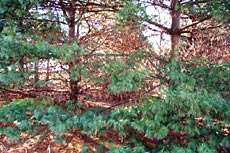|
A
proper windbreak involves more than just planting a lot of trees
around the farmstead. Windbreaks provide maximum benefits by
sheltering buildings from winter winds, so the first thing to do is
determine the direction of prevailing winds.
The
prevailing winds for most of Illinois are from a northwesterly
direction; so for the best protection, windbreaks should be located
on the north and west sides of the farmstead.
The
shapes of farmsteads vary, but the most effective and easily
arranged windbreak is designed in the form of an L, with the point
to the northwest. The windbreak should be set no closer than 50 feet
from the buildings to prevent dead-air pockets around buildings in
the summer and to minimize snowdrifts in the winter. If you have
room, 100 feet is even better.

Generally,
evergreen windbreaks consist of three rows, with trees in the middle
row planted to alternate between those of the outside rows. The rows
should be at least 16 feet apart, with the trees spaced 16 feet
apart within the row. If planted too close to each other, the trees
will crowd and shade each other as they mature, killing the lower
branches needed to slow surface wind.
How
many trees to buy is another consideration. One way to estimate the
number of trees required is to multiply the length of the windbreak
by 0.20. Most windbreaks need 100 to 150 trees. Buying a few extra
trees might be wise, to replace losses or to plant around a garden.
For
best protection, the windbreak should be continuous and
uninterrupted, but if access is needed to nearby fields, avoid
making gaps at the northwest corner or along the legs. This can be
done by overlapping the legs, providing a continuous row of trees,
yet allowing space for access to fields.

[to top of second column in
this article]
|

You
can attract songbirds and other wildlife to your windbreak and even
discourage pest species by taking a few special considerations in
the design stage. Windbreaks are valuable additions to wildlife
habitat in regions of intensive agriculture. Although many species
of wildlife will benefit from windbreaks, not all of them will be
conspicuous. Some species are nocturnal and some are secretive. A
good design and a well-laced bird feeder will bring many species
into view.
The
single most important variable influencing the use of a windbreak by
wildlife is its size. The windbreak will be used by more wildlife in
direct proportion to its length and width, that is, the number of
rows and their length.

A
diversity of shrub and evergreen species will attract more wildlife
than will monotypic rows of single species. Various species produce
fruit at different times of the year, providing modest amounts of
food over an extended period of time. Where windbreaks are composed
of just one or two species, the fruit comes on at one time and
cannot be fully utilized by resident wildlife, or it may attract
undesirable concentrations of migrating birds for brief periods in
the fall. A diversity of tree and shrub species will also reduce the
impact of insect or disease problems in the windbreak.
Species
known to be good for attracting nesting birds include spruce, pine,
arrowwood, and hawthorn. Species with favored fruits include
American plum, Chokeberry, hawthorn, high-bush cranberry, arrowwood
and dogwood.
Upcoming
events
Jan.
29 — Illinois Tillage Seminar, Spring Valley; reservations by Jan.
22
Jan.
31 — Horse Nutrition Workshop, Lincoln; reservations by Jan. 24
Feb.
4 — Entomology Roundtable, Lincoln; reservations by Jan. 27
Feb.
12 — Illinois Tillage Conference, Bloomington; reservations by
Feb. 5
[John
Fulton]
|
|
Jananne
Finck, nutrition and wellness educator with the University of
Illinois Extension, will present information about the selection,
preparation, storage and service of grain products for your meals.
She is a registered dietitian based at the Springfield Extension
center.
Finck
will discuss the role grain plays in a nutritious diet and cover the
planning of meals to include breads, cereals and other dishes using
grain products. Information on safe methods of handling grain
products will also be reviewed. Tasting will be encouraged.
Anyone
interested is invited. Contact the Logan Extension office for
preregistration, which is due Jan. 10, one week before the program.
There is no fee to attend. For more information and to register
ahead, please call the office at (217) 732-8289.
|

|
|
New youth
development educator
joins local U of I Extension staff
[DEC.
13, 2001] The
University of Illinois Extension has recently appointed Shelly
Dittmer to the position of unit educator for youth development. She
will be responsible for coordinating educational programs for the
youth of Logan County.
Prior
to this position, Shelly taught English and speech communications at
the high school level for 10 years.
She
received her bachelor’s degree in English education from Illinois
State University and a master’s degree in educational
administration from Western Illinois University.
Shelly
and her husband, Todd, reside in Peoria.
Shelly
is excited about this new opportunity and looks forward to working
with the people of Logan County.
|